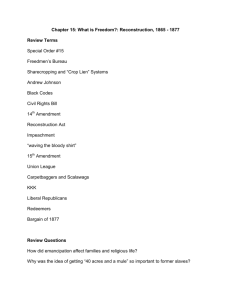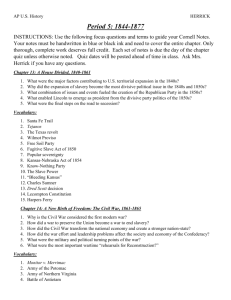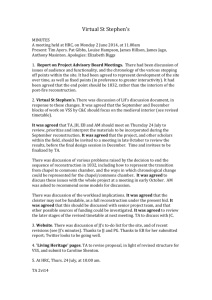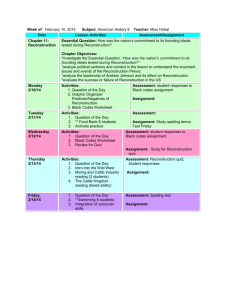Chapter 12 Sections 3 and 4 - East Lycoming School District
advertisement
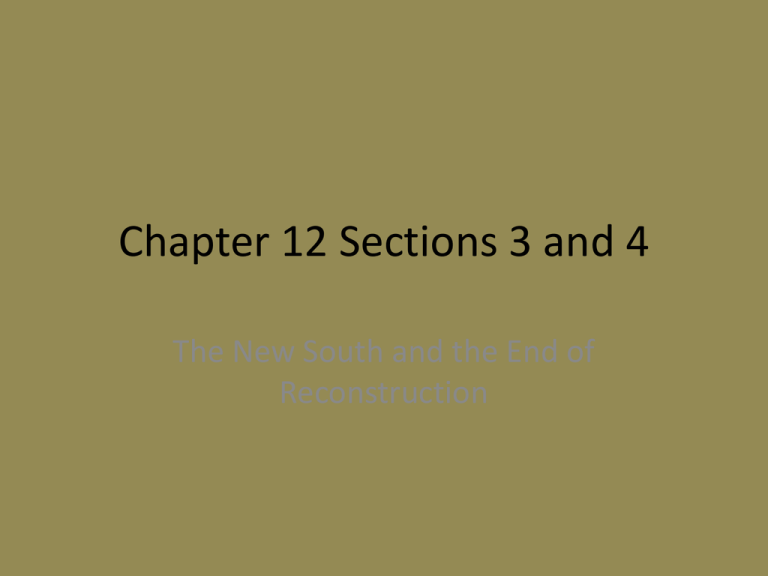
Chapter 12 Sections 3 and 4 The New South and the End of Reconstruction Why did planters have trouble finding people to work for them? • The work too closely resembled slavery • Workers often left to look for better jobs and more money Sharecropping • A family would farm some portion of a planter’s land • A payment, the family would receive a portion of the crops • The planter would usually provide a place to live Sharecropping • Harsh life • Could be evicted after a harvest • Were often charged rent, leaving them in debt • Could not leave plantation until debt paid – Left them stuck Tenant Farming • Did not own the land they farmed • Paid to rent the land • Could choose what crops to grow • Enjoyed a higher social status than sharecroppers How did sharecroppers and tenant farming differ? • Tenant farmers had a little more freedom – Could choose what plants to grow – What hours to work • Sharecroppers farmed someone else’s land in exchange for a portion of the crop at harvest and for housing…sometimes How did changes in farming affect the long term health of the South’s economy? • Too make money, Southern planters had to grow cash crops (like cotton) rather than food crops • This required the South to import more food • This created more expenses for Southerners in poverty Infrastructure • The public property and services a society uses – This was almost completely destroyed in the south – Left opportunities for business opportunities – South used Reconstruction money to build: roads, bridges, canals, railroads, and telegraph lines, public schools How did railroads contribute to the growth of cities? • Railroads rebuilt and extended in the south – Towns and villages along the railroad turned into cities – Trade and business flourished – More commerce and larger populations Why was southern industrial growth limited? • Southern factories often did not make finished goods-focused on the early stages of manufacturing • Profits from the cotton industries shifted to the North • Northern companies that dyed the cotton and sold the finished product made the money What were the sources of funding for Reconstruction programs? • Congress • Private investors • Heavy taxes Enforcement Act of 1870 • Banned the use of terror, force, or bribery to prevent people from voting because of their race. • Meant to stop the actions of the KKK Why did Congress pass the Enforcement Act of 1870? • KKK spreading terror throughout the South • Desired to eliminate the Republican party • Desired to keep African Americans in a submissive role in society • Tortured, kidnapped, and murdered Solid South • A strong bloc of former Confederate and Democratic voters in the South • Blocked many federal Reconstruction policies • Reversed many Reconstruction reforms Compromise of 1877 • Rutherford B. Hayes lost the popular vote in the 1876 Presidential election to Samuel Tilden • But, the electoral results were disputed • Both candidates were claiming victory in Louisiana, South Carolina, and Florida Compromise of 1877 • A Congressional commission was set up to resolve the problem – Composed of more republicans than Democrats – Democrats rejected the commissions decision Compromise of 1877 • The 2 parties made a deal • Hayes would win the Presidency • In exchange for the Presidency, he would pull the troops out of the South and give money to projects in the South • Democrats regain control of Southern politics • Reconstruction over What 4 factors contributed to the end of Reconstruction? • Corruption- poor government leadership • The economy- lots of taxes and spending led to deep Southern debt • Violence • The Democratic return to power in the South What were the successes and failures of Reconstruction? • Successes • Union is restored • South’s economy grows and new wealth is created in the North • 14th and 15th Amendments offer blacks citizenship and equal protection under the law • Freedmen’s Bureau and other organizations help many black families obtain housing, jobs, and schooling • Southern states adopt a system of mandatory education What were the successes and failures of Reconstruction? • Failures • Many white southerners remain bitter toward the federal government and the Republican Party • The South is sow to industrialize • After troops leave, many blacks are denied their right to vote • Many black and white farmers remain caught in a cycle of poverty • Racism continues in the North and South

